NASCAM (NAnoSCAle Modeling)
-----------------------------------------------------------------------------------------------------------
NEWS (may 2021)
This website is related to the free version of NASCAM (V 4.6.X) which includes improvements and optimizations of the user GUI, depositon and diffusion algorithms and coding. It allows the simuation of METAL ONLY film growth (see the description below).
Improved version (additionnal plugins, reactive deposition, ..) of NASCAM is now sold by Innovative Coating Solutions (ICS), exclusive dealer of NASCAM simulation suite. Have a look to https://www.incosol4u.com/ to discover ICS.
NASCAM 4.6.X (this version)
|
NASCAM 4.8.X
|
|---|---|
|
|
-----------------------------------------------------------------------------------------------------------
NASCAM vERSION 4.6.2 rev 6
This version includes improvements and optimizations of the user GUI, depositon and diffusion algorithms and coding. As a result, user interface is better, and the code is faster by at least one order of magnitude.
It also includes- New or improved plugins: Electrical, Colors, Make_substrate, Output_browser, Scan_to_Nascam, Slices.
- New examples: SEM Xsection substrate, Incoherent light effect, Moving substrate.
See the link at the bottom to freely download it.
-----------------------------------------------------------------------------------------------------------
Code DeveloPment
This code is developed at Namur University, Belgium, and numerous people are or have been involved (by alphabetical order): B. Bera, M. Evrard, A. Fauroux, S. Lucas, P. Moskovkin, J. Muller, F. Nita, S. Lucas
Funded by
- 2011-2013: Pôle d'Attraction Inter-universitaire (IAP), Belgium
- 2013-2015: Computer Aided Process Refinement for Intelligent Coatings (CAPRICE) , Walloon region/Cornet project n° 1217777,
- 2016-...: CORNET EU funding (VICIA project), Feder (H2020) and lab financial resources.
Description
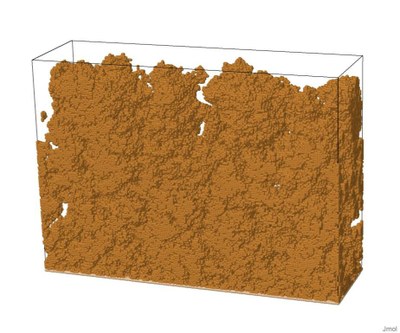
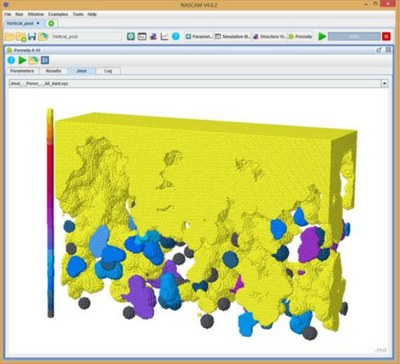
This code is developed to simulate the time evolution of atoms deposited on a substrate. It is based on the kinetic Monte Carlo (kMC) method. kMC can be used for modeling different processes at the surface, such as the growth of films during deposition or the development of films post deposit, at the atomic scale. The goal of the kinetic Monte Carlo method is to mimic real experiments through simulations. Because kMC does not take into account the vibrational movement of atoms it is possible to use kMC to model the evolution of a system for longer periods of time, unlike the Molecular Dynamics simulation which can only be used to simulate the dynamics of a system for a short period of time, about 10-9s. Depending on the number of atoms in the system, along with some other parameters such as temperature and atomic properties, the physical time might be hundreds to thousands of seconds.
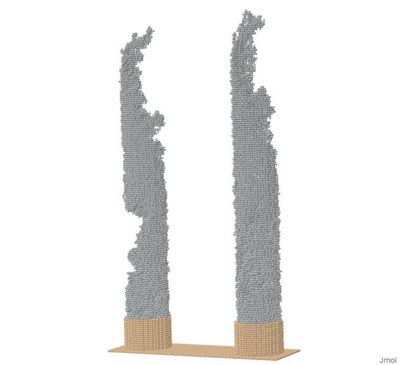
In the current version, the following events are implemented:
- free diffusion at the substrate and layer level,
- hop with same number or increase of neighboring atoms number,
- hop with decrease of neighboring atoms number,
- detachment from the island,
- hop up from one level to another,
- hop down from one level to another,
- detrapment from a substrate defect,
- evaporation from substrate or layer
- sputtering if the transferred energy to an adatom is larger than its surface binding energy.
If diffusion is to be considered, the user has to specify the activation energy for every one of these events.

Several examples are provided: Diffusion limited aggregation, fractal growth, Otswald ripening, multilayer deposition, Glancing Angle Deposition (GLAD), ....
In addition, Porosity, Optics, Electrics and Colors are plugins developed by our team to evaluate the physical properties of the films simulated by NASCAM.
User can develop its own plugin and add it to the new graphical user interface.
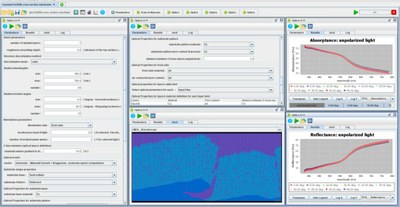
You can freely download NASCAM after filling the registration form (see the link at the bottom of this page). By registering, you will be entitled to any future releases.
Several papers benchmarking NASCAM with real cases have been published:
- “Simulation at high temperature of atomic deposition, islands coalescence, Ostwald and inverse Ostwald ripening with a general simple kinetic Monte Carlo code”, S. Lucas, P. Moskovkin, Thin Solids Films (2010), Volume 518, Issue 18, 1 July 2010, Pages 5355-5361.
- “Surface phenomena involved in the formation of Co nanoparticles on amorphous carbon and SiO2 deposited by magnetron sputtering”, S. Lucas, J.F. Colomer, C. Bittencourt, P. Moskovkin, N. Moreau, Applied Physics A: Materials Science & Processing, Volume 99, Number 1 / 2010, 125-138.
- “Computer simulations of the early stage growth of Ge clusters at elevated temperatures, on patterned Si substrate using the kinetic Monte Carlo method.”, P. Moskovkin and S. Lucas, Thin Solids Film, Volume 536, 1 / June 2013, 313–317.
- “On the formation of the porous structure in nanostructured a-Si coatings deposited by dc magnetron sputtering at oblique angles", G. Vanda, P. Moskovkin, R. Alvarez, J. Caballero-Hernandez, R. Schierholz, B. Bera, J. Demarche, A. Palmero, A. Fernandez, S. Lucas, Nanotechnology. 2014 Sep 5;25(35):355705.
- "Synthesis of nanostructured Ti thin films by combining glancing angle deposition and magnetron sputtering: a joint experimental and modeling study",J.Dervaux, P.-A.Cormier, P.Moskovkin, O.Douheret, S.Konstantinidis, R.Lazzaroni, S.Lucas, R.Snyders,
Thin Solid Films, Volume 636, 2017, 644-657.
We ask you to cite at least the article published in Thin Solids Films (2010-2013) in any of your publications involving NASCAM.
Enjoy easy Monte-Carlo !!
Prof. S. Lucas
-----------------------------------------------------------------------------------------------------------
Past NEWS
- NASCAM v 3.5d3 has been presented at the European Plasma Conference HTPP11 - Bruxelles (www.htpp11.eu/), and released on september 28th 2010.
- NASCAM Workshop (2009): two-days workshop on plasma and plasma simulation softwares ( September 1th and 2th 2009).
The plasma simulation session was intended to give the opportunity to discover and test three computer programs running on personal computer and able to simulate plasma and/or film growth: Plasimo, Simtra and NASCAM.
Over 40 scientists attended to the lectures and the practices.
Among the proposed work, they had the possibility to discover and evaluate NASCAM through the simulation of several cases: i- diffusion limited aggregation, ii- deposition on a "flat" substrate at various T° and energies, deposition on a pre-patterned substrate at various T° and energies, simulation of Oswald ripening and inverse Oswatd ripening via the annealing process of pre-defined structres deposited on a surface.
- NASCAM and SIMTRA combined workshop (2017): this four-day workshop (19-21th september 2017) was dedicated
to the understanding and use of both SIMTRA (Prof. D. Depla, UGent) and NASCAM (prof. S. Lucas, UNamur) codes. This combined simulation workshop gave the participant the possibility to interact with users with the aim to tackle the simulation of a whole deposition process, from the geometrical description of a
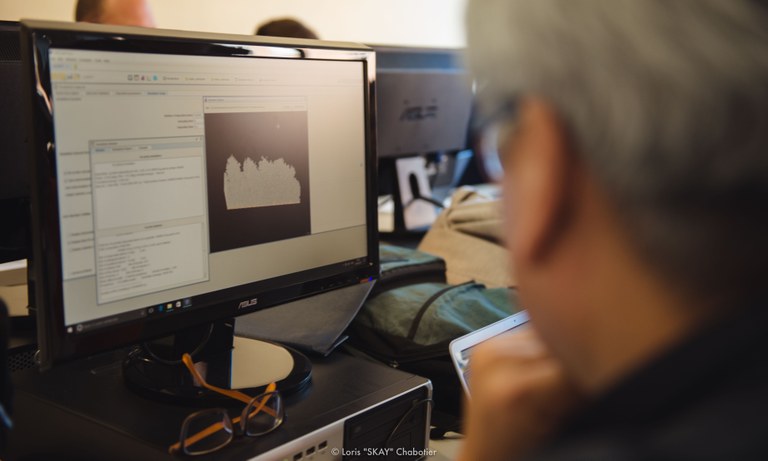 deposition chamber to the evaluation of final coating properties. About 40 participants learned how to use SIMTRA and NASCAM.
deposition chamber to the evaluation of final coating properties. About 40 participants learned how to use SIMTRA and NASCAM.
-----------------------------------------------------------------------------------------------------------
RELEASES
Version 2 (2008)
Version 3.2 (october 2009)
Version 3.5d3 (September 2010)
Version 4.1 (June 2011)
Version 4.3d (June 2012)
Version 4.5 (July 2014)
Version 4.5.1 (October 2016)
- Improve calculation speed
- Change files format to migrate totally to JMOL.
- New graphical user interface: NASCAM_GUI written in Java: provide a clear and easy to use interface for simulations as well as to provide an easy way for scientists to implements plugins to analyze the simulated films.
- Porosity and Optical plugins
Version 4.6.1 (September 2017)
- Improved calculation speed specially for diffusion
- Corrected a number of bugs, simplified internal architecture
- Improved interface: now several cases may run in //, ....
- Bug report possible at: https://goo.gl/forms/bTiOLEobdtEAGnps1
Version 4.6.2 Rev 5-6 (April 2018)
- Executable is a 64 bit version.
- Faster and faster
- Deposition up to 5 millions atoms (even more if you wish)
- Bug corrections (Thanks Florin)
- New plugins: Electrical, Colors, Make_substrate, Output_browser, Scan_to_Nascam, Slices
- New examples: SEM Xsection substrate, Incoherent light effect, Moving substrate









